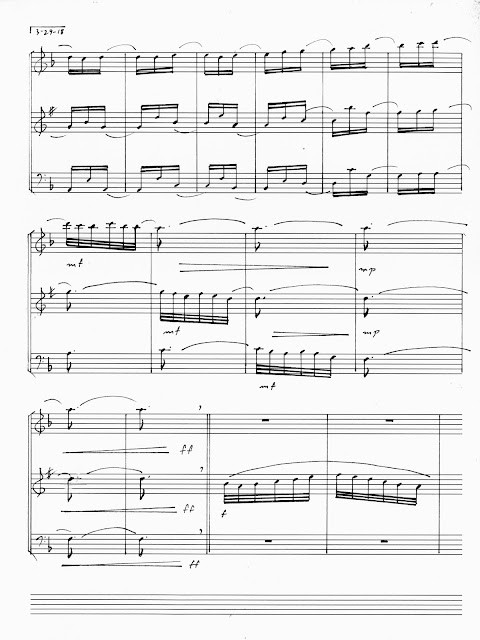There many ways to create a classical music program for July 4th. Most programmers just take the path of least resistance. While tradition is important (and comforting), our American musical heritage is rich, diverse, and exciting. And it can add deeper meaning to our Independence Day celebration.
July 4, 2018, I'm hosting a three-hour radio program on
WTJU. Here's what I've programmed -- and why.
Patriotic Music of the Revolution
I'm airing four selections that were popular in the Revolutionary and Federalist Eras.
Yankee Doodle (1770),
The Boston March (1774),
The Liberty Tree (1780), and
Jefferson and Liberty (1810).
The performances by Joel Cohen and the Boston Camerata are historically authentic. These rough-hewn songs shine with optimism and idealistic energy. This is the America of the Founding Fathers.
Patriotic Music about the Revolution
I'm also featuring Michael Torke's latest work,
Unconquered (2018). It commemorates the 1777 Battle of Saragota, which marked a turning point in the War of Independence. The final movement, "Liberty" expresses optimism for the fledgling nation.
Patriotic Music from Mr. Jefferson's University
WTJU is a broadcast service of the University of Virginia. Several of my selections are related either to the University or its founder, Thomas Jefferson.
Made in America (2001) by American composer Joan Tower was jointly commissioned by 65 small and regional American orchestras. The piece was premiered in all 50 states over a two-year period.
It's a set of variations on
America the Beautiful. One of the commissioning orchestras (and therefore one of Tower's tour stops), was the Charlottesville and University Symphony Orchestra (now the
Charlottesville Symphony).
Randall Thompson wrote
The Testament of Freedom (1943) while on the faculty of the University's music department. It was written for the University of Virginia's Glee Club to commemorate the bicentennial of Jefferson's birth. Thompson used Jefferson's writings for the text, delivering a message of hope to a nation fighting for freedom in the Second World War.
Patriotic Music in an American voice
Aaron Copland is the American classical composer most often programmed for the 4th. Sure "Fanfare for the Common Man" has a populist appeal. But he wasn't the only one forging an American identity in the field. Contemporaries such as Randall Thompon (see above), Walter Piston, Virgil Thomson, William Schuman and Roy Harris also contributed to American music.
I'm airing Roy Harris' 1040 "American Creed." It's a short orchestral work with two parts: "Freedom to Dream" and "Freedom to Build." Quintessentially American concepts expressed in an American classical style.
Patriotic Music of Inclusion
We're all immigrants -- the only difference is how recently we arrived. Henry Cowell's "American Melting Pot" (1940) celebrates our immigrant nation by blending musical traditions of several cultures that contributed to the American experience. The movements are labeled: Chorale (Teutonic-American), Air (Afro-American), Satire (Franco-American), Alapna (Oriental-American), Slavic Dance (Slavic-American), Rhumba (Latin-American), Square Dance (Celtic-American).
And let's not forget Native Americans. I'm airing Charles Tomlinson Griffes
Two Sketches Based on Indian Themes (1910). Not all of his source material is identified, but one of his melodies is based on a farewell song of Chippewas.
For something a little more familiar, I'm including Leonard Bernstein conducting his
Symphonic Dances from "West Side Story." What could be more American than Broadway tunes, jazz, and Latino/Ameican music?
Alophus Hailstork is one of the most preeminent African-American composers living today. And he lives right here in Virginia. His work
An American Port of Call captures all the bustling action of an American seaport.
Patriotic Music Beyond the Same-Old Same-Old
You can't have a 4th of July concert without a Sousa march. Plenty of folks will program the
Stars and Stripes Forever. I chose his
Hail to the Spirit of Liberty March. John Philip Sousa and his band represented the United States at the 1900 Paris Exposition. The march was written for this event. The band played it to great acclaim throughout Europe.
Many people think American classical music ended with Aaron Copland and/or Leonard Bernstein who are dead. It didn't. Kenneth Fuchs (b. 1956) is one of several American composers writing in an accessible contemporary style. I chose his 2008
American Rhapsody, a beautiful romance for violin and orchestra work that deserves to be better known.
Patriotic fanfares can be stirring. Morton Gould's
American Salute (1943) was written literally overnight for a wartime broadcast. It's a set of variations on the Civil War tune
When Johnny Comes Marching Home. Two historic references in one!
America is a standard patriotic piece. Charles Ives'
Variations on America (1891) is anything but.
And finally, everyone loves a good march. But which one to play? I went with Henry Mancini's march from the movie "The Great Race." It's a mash-up of just about every famous march with a sprinkle of Mancini magic.
And here's the thing -- I still only scratched the surface. America has an amazing treasury of music written by us for us. And it keeps growing every year. That's what my show tomorrow will be all about -- looking at where we've been, and how far we've come.*
*musically, that is















































